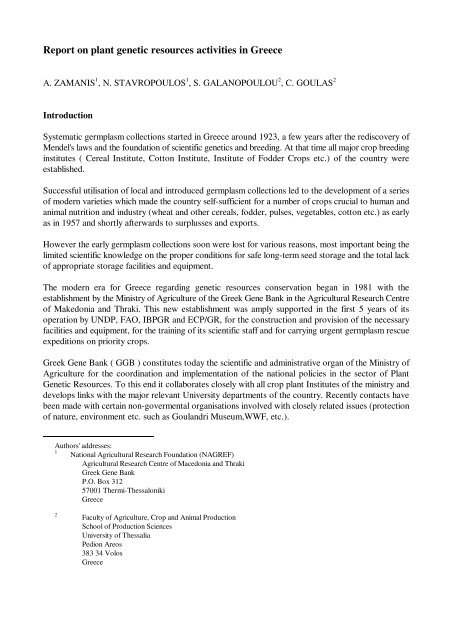Integration of Conservation Strategies of Plant Genetic ... - Genres
Integration of Conservation Strategies of Plant Genetic ... - Genres
Integration of Conservation Strategies of Plant Genetic ... - Genres
Create successful ePaper yourself
Turn your PDF publications into a flip-book with our unique Google optimized e-Paper software.
Report on plant genetic resources activities in Greece<br />
A. ZAMANIS 1 , N. STAVROPOULOS 1 , S. GALANOPOULOU 2 , C. GOULAS 2<br />
Introduction<br />
Systematic germplasm collections started in Greece around 1923, a few years after the rediscovery <strong>of</strong><br />
Mendel's laws and the foundation <strong>of</strong> scientific genetics and breeding. At that time all major crop breeding<br />
institutes ( Cereal Institute, Cotton Institute, Institute <strong>of</strong> Fodder Crops etc.) <strong>of</strong> the country were<br />
established.<br />
Successful utilisation <strong>of</strong> local and introduced germplasm collections led to the development <strong>of</strong> a series<br />
<strong>of</strong> modern varieties which made the country self-sufficient for a number <strong>of</strong> crops crucial to human and<br />
animal nutrition and industry (wheat and other cereals, fodder, pulses, vegetables, cotton etc.) as early<br />
as in 1957 and shortly afterwards to surplusses and exports.<br />
However the early germplasm collections soon were lost for various reasons, most important being the<br />
limited scientific knowledge on the proper conditions for safe long-term seed storage and the total lack<br />
<strong>of</strong> appropriate storage facilities and equipment.<br />
The modern era for Greece regarding genetic resources conservation began in 1981 with the<br />
establishment by the Ministry <strong>of</strong> Agriculture <strong>of</strong> the Greek Gene Bank in the Agricultural Research Centre<br />
<strong>of</strong> Makedonia and Thraki. This new establishment was amply supported in the first 5 years <strong>of</strong> its<br />
operation by UNDP, FAO, IBPGR and ECP/GR, for the construction and provision <strong>of</strong> the necessary<br />
facilities and equipment, for the training <strong>of</strong> its scientific staff and for carrying urgent germplasm rescue<br />
expeditions on priority crops.<br />
Greek Gene Bank ( GGB ) constitutes today the scientific and administrative organ <strong>of</strong> the Ministry <strong>of</strong><br />
Agriculture for the coordination and implementation <strong>of</strong> the national policies in the sector <strong>of</strong> <strong>Plant</strong><br />
<strong>Genetic</strong> Resources. To this end it collaborates closely with all crop plant Institutes <strong>of</strong> the ministry and<br />
develops links with the major relevant University departments <strong>of</strong> the country. Recently contacts have<br />
been made with certain non-govermental organisations involved with closely related issues (protection<br />
<strong>of</strong> nature, environment etc. such as Goulandri Museum,WWF, etc.).<br />
Authors' addresses:<br />
1<br />
National Agricultural Research Foundation (NAGREF)<br />
Agricultural Research Centre <strong>of</strong> Macedonia and Thraki<br />
Greek Gene Bank<br />
P.O. Box 312<br />
57001 Thermi-Thessaloniki<br />
Greece<br />
2<br />
Faculty <strong>of</strong> Agriculture, Crop and Animal Production<br />
School <strong>of</strong> Production Sciences<br />
University <strong>of</strong> Thessalia<br />
Pedion Areos<br />
383 34 Volos<br />
Greece










